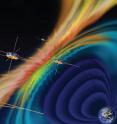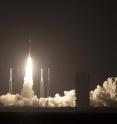NASA spacecraft in Earth's orbit, preparing to study magnetic reconnection
Following a successful launch at 10:44 p.m. EDT Thursday, NASA's four Magnetospheric Multiscale (MMS) spacecraft are positioned in Earth's orbit to begin the first space mission dedicated to the study of a phenomenon called magnetic reconnection. This process is thought to be the catalyst for some of the most powerful explosions in our solar system. The spacecraft, positioned one on top of the other on a United Launch Alliance Atlas V 421 rocket, launched from Cape Canaveral Air Force Station, Florida. After reaching orbit, each spacecraft deployed from the rocket's upper stage sequentially, in five-minute increments, beginning at 12:16 a.m. Friday, with the last separation occurring at 12:31 a.m. NASA scientists and engineers were able to confirm the health of all separated spacecraft at 12:40 a.m.
"I am speaking for the entire MMS team when I say we're thrilled to see all four of our spacecraft have deployed and data indicates we have a healthy fleet," said Craig Tooley, project manager at NASA's Goddard Space Flight Center in Greenbelt, Maryland.
Over the next several weeks, NASA scientists and engineers will deploy booms and antennas on the spacecraft, and test all instruments. The observatories will later be placed into a pyramid formation in preparation for science observations, which are expected to begin in early September.
"After a decade of planning and engineering, the science team is ready to go to work," said Jim Burch, principal investigator for the MMS instrument suite science team at the Southwest Research Institute in San Antonio (SwRI). "We've never had this type of opportunity to study this fundamental process in such detail."
The mission will provide the first three-dimensional views of reconnection occurring in Earth's protective magnetic space environment, the magnetosphere. Magnetic reconnection occurs when magnetic fields connect, disconnect, and reconfigure explosively, releasing bursts of energy that can reach the order of billions of megatons of trinitrotoluene (commonly known as TNT). These explosions can send particles surging through space near the speed of light.
Scientists expect the mission will not only help them better understand magnetic reconnection, but also will provide insight into these powerful events, which can disrupt modern technological systems such as communications networks, GPS navigation, and electrical power grids.
By studying reconnection in this local, natural laboratory, scientists can understand the process elsewhere, such as in the atmosphere of the sun and other stars, in the vicinity of black holes and neutron stars, and at the boundary between our solar system's heliosphere and interstellar space.
The spacecraft will fly in a tight formation through regions of reconnection activity. Using sensors designed to measure the space environment at rates100 times faster than any previous mission.
"MMS is a crucial next step in advancing the science of magnetic reconnection -- and no mission has ever observed this fundamental process with such detail," said Jeff Newmark, interim director for NASA's Heliophysics Division at the agency's Headquarters in Washington. "The depth and detail of our knowledge is going to grow by leaps and bounds, in ways that no one can yet predict."
MMS is the fourth mission in the NASA Solar Terrestrial Probes Program. Goddard built, integrated and tested the four MMS spacecraft and is responsible for overall mission management and operations. The principal investigator for the MMS instrument suite science team is based at the SwRI. Science operations planning and instrument commanding are performed at the MMS Science Operations Center at the University of Colorado Boulder's Laboratory for Atmospheric and Space Physics.
More information about the MMS mission is available at:
Source: NASA
Other sources
- NASA spacecraft in Earth's orbit, preparing to study magnetic reconnectionfrom PhysorgFri, 13 Mar 2015, 20:20:43 UTC
- NASA spacecraft in Earth’s orbit, preparing to study magnetic reconnectionfrom Science DailyFri, 13 Mar 2015, 16:00:23 UTC
- NASA launches four spacecraft to solve magnetic mysteryfrom PhysorgFri, 13 Mar 2015, 8:00:40 UTC
- Nasa satellites safely in orbit after Atlas V rocket launchfrom The Guardian - ScienceFri, 13 Mar 2015, 8:00:17 UTC
- NASA launches satellites to probe magnetic mysteryfrom CBSNews - ScienceFri, 13 Mar 2015, 7:00:24 UTC
- NASA Mission to Study Magnetic Explosions Lifts Offfrom NY Times ScienceFri, 13 Mar 2015, 5:10:12 UTC
- Rocket blasts off with NASA magnetic field probesfrom Reuters:ScienceFri, 13 Mar 2015, 4:30:14 UTC
- Spectacular Night Launch Sends NASA Satellites on Hunt for Magnetic Collisionsfrom Space.comFri, 13 Mar 2015, 4:00:26 UTC
- Lift-Off! NASA Launches MMS Satellite Quartet | Videofrom Space.comFri, 13 Mar 2015, 3:40:09 UTC
- NASA spacecraft blast off to provide 3D views of magnetic field reconnectionfrom CBC: Technology & ScienceFri, 13 Mar 2015, 3:40:04 UTC
- Magnetosphere Probes Blast Off to Study Space Stormsfrom MSNBC: ScienceFri, 13 Mar 2015, 3:30:05 UTC
- Nasa to launch four spacecraft to track Earth and sun's magnetic collisionsfrom The Guardian - ScienceThu, 12 Mar 2015, 19:21:18 UTC
- NASA to study Earth and sun's explosive interplayfrom CBSNews - ScienceThu, 12 Mar 2015, 18:31:19 UTC
- NASA mission to study magnetic reconnectionfrom UPIThu, 12 Mar 2015, 17:50:11 UTC
- NASA set to launch four spacecraft to solve magnetic mysteryfrom PhysorgThu, 12 Mar 2015, 17:20:27 UTC
- NASA set to launch 4 spacecraft to solve magnetic mysteryfrom AP ScienceThu, 12 Mar 2015, 15:30:25 UTC
- NASA Satellite Quartet Aims to Crack Magnetic Mystery Near Earthfrom Live ScienceThu, 12 Mar 2015, 15:00:09 UTC
- NASA Mission to Track Earth's Magnetic Collisions Launching Tonight: Watch Livefrom Space.comThu, 12 Mar 2015, 13:30:23 UTC
- NASA Mission to Measure Earth’s Magnetic Collisionsfrom NY Times ScienceThu, 12 Mar 2015, 9:20:11 UTC
- NASA Satellite Quartet Aims to Crack Magnetic Mystery Near Earthfrom Space.comWed, 11 Mar 2015, 12:00:31 UTC
- NASA to investigate magnetic explosionsfrom PhysorgWed, 11 Mar 2015, 12:00:17 UTC
- Magnetospheric multiscale spacecraft poised for launchfrom PhysorgTue, 10 Mar 2015, 23:10:13 UTC
- 4 NASA Satellites to Launch on Magnetic Field Mission This Thursdayfrom Space.comTue, 10 Mar 2015, 22:10:06 UTC
- 'Don’t Cross The Streams!' NASA Studying Magnetic Explosions | Videofrom Space.comTue, 10 Mar 2015, 20:47:51 UTC
- NASA to Investigate Magnetic Explosionsfrom Science @ NASATue, 10 Mar 2015, 20:10:07 UTC
- Satellite Quartet: NASA's Magnetospheric Multiscale Mission in Picturesfrom Space.comTue, 10 Mar 2015, 16:30:22 UTC
- How 4 NASA Satellites Will Study Magnetic Fields of Earth & Sun (Infographic)from Space.comTue, 10 Mar 2015, 16:30:21 UTC

